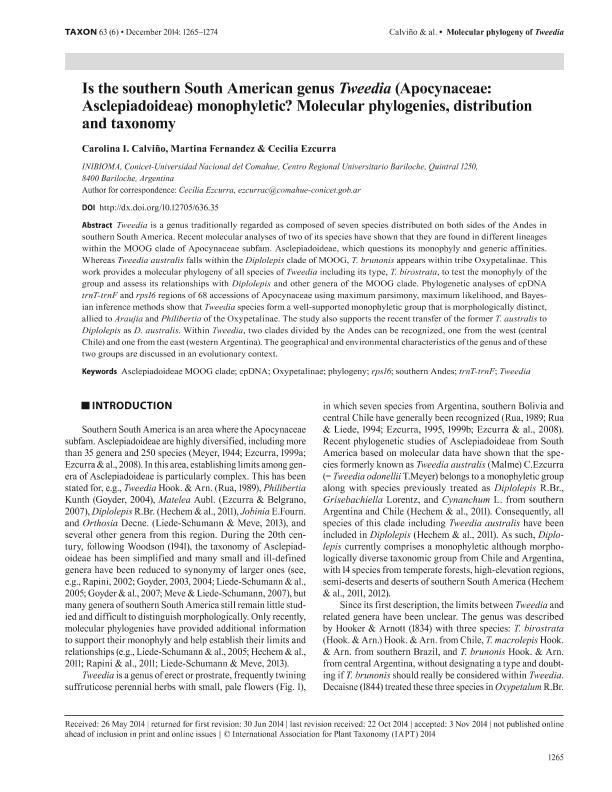Mostrar el registro sencillo del ítem
dc.contributor.author
Calviño, Carolina Isabel

dc.contributor.author
Fernández, Martina

dc.contributor.author
Ezcurra, Cecilia

dc.date.available
2017-01-26T22:00:26Z
dc.date.issued
2014-12
dc.identifier.citation
Calviño, Carolina Isabel; Fernández, Martina; Ezcurra, Cecilia; Is the southern South American genus Tweedia (Apocynaceae: Asclepiadoideae) monophyletic? Molecular phylogenies, distribution and taxonomy; International Association For Plant Taxonomy; Taxon; 63; 6; 12-2014; 1265-1274
dc.identifier.issn
0040-0262
dc.identifier.uri
http://hdl.handle.net/11336/12062
dc.description.abstract
Tweedia is a genus traditionally regarded as composed of seven species distributed on both sides of the Andes in southern South America. Recent molecular analyses of two of its species have shown that they are found in different lineages within the MOOG clade of Apocynaceae- Asclepiadoideae, which questions its monophyly and generic affinities. Whereas Tweedia australis falls within the Diplolepis clade of MOOG, Tweedia brunonis appears within the tribe Oxypetalinae. This work provides a molecular phylogeny of all species of Tweedia including its type, Tweedia birostrata, to test the monophyly of the group and assess its relationships with Diplolepis and other genera of the MOOG clade. Phylogenetic analyses of cpDNA trnT-trnF and rps16 regions of 68 accessions of Apocynaceae using maximum parsimony, maximum likelyhood, and Bayesian inference methods show that Tweedia species form a well-supported monophyletic group that is morphologically distinct, allied to Araujia and Philibertia of the Oxypetalinae. The study also supports the recent transfer of the former Tweedia australis to Diplolepis as Diplolepis australis. Within Tweedia, two clades divided by the Andes can be recognized, one from the west (central Chile) and one from the east (western Argentina). The geographical and environmental characteristics of the genus and of these two groups are discussed in an evolutionary context.
dc.format
application/pdf
dc.language.iso
eng
dc.publisher
International Association For Plant Taxonomy

dc.rights
info:eu-repo/semantics/openAccess
dc.rights.uri
https://creativecommons.org/licenses/by-nc-sa/2.5/ar/
dc.subject
Asclepiadoideae Moog Clade
dc.subject
Oxypetalinae
dc.subject
Phylogeny
dc.subject
Southern Andes
dc.subject
Rps16
dc.subject
Trnt-Trnf
dc.subject
Tweedia
dc.subject.classification
Ciencias de las Plantas, Botánica

dc.subject.classification
Ciencias Biológicas

dc.subject.classification
CIENCIAS NATURALES Y EXACTAS

dc.title
Is the southern South American genus Tweedia (Apocynaceae: Asclepiadoideae) monophyletic? Molecular phylogenies, distribution and taxonomy
dc.type
info:eu-repo/semantics/article
dc.type
info:ar-repo/semantics/artículo
dc.type
info:eu-repo/semantics/publishedVersion
dc.date.updated
2016-12-12T14:23:54Z
dc.journal.volume
63
dc.journal.number
6
dc.journal.pagination
1265-1274
dc.journal.pais
Austria

dc.journal.ciudad
Viena
dc.description.fil
Fil: Calviño, Carolina Isabel. Consejo Nacional de Investigaciones Científicas y Técnicas. Centro Científico Tecnológico Patagonia Norte. Instituto de Investigación En Biodiversidad y Medioambiente; Argentina. Universidad Nacional del Comahue; Argentina
dc.description.fil
Fil: Fernández, Martina. Consejo Nacional de Investigaciones Científicas y Técnicas. Centro Científico Tecnológico Patagonia Norte. Instituto de Investigación En Biodiversidad y Medioambiente; Argentina. Universidad Nacional del Comahue; Argentina
dc.description.fil
Fil: Ezcurra, Cecilia. Consejo Nacional de Investigaciones Científicas y Técnicas. Centro Científico Tecnológico Patagonia Norte. Instituto de Investigación En Biodiversidad y Medioambiente; Argentina. Universidad Nacional del Comahue; Argentina
dc.journal.title
Taxon

dc.relation.alternativeid
info:eu-repo/semantics/altIdentifier/url/http://www.ingentaconnect.com/content/iapt/tax/2014/00000063/00000006/art00007
dc.relation.alternativeid
info:eu-repo/semantics/altIdentifier/doi/https://doi.org/10.12705/636.35
Archivos asociados
